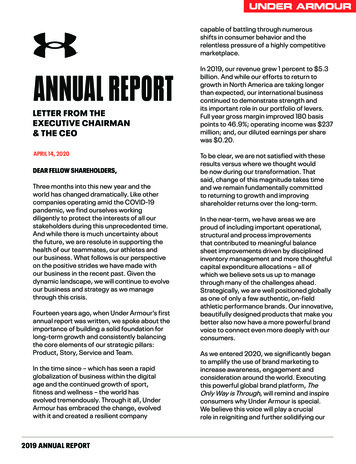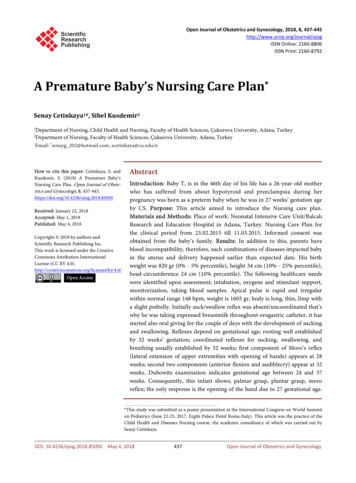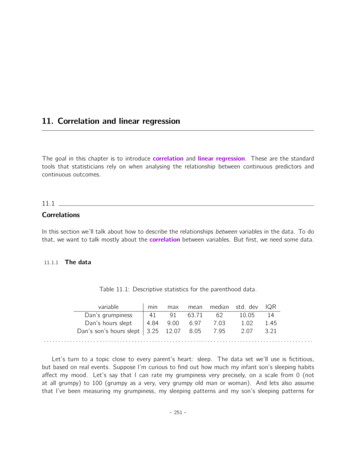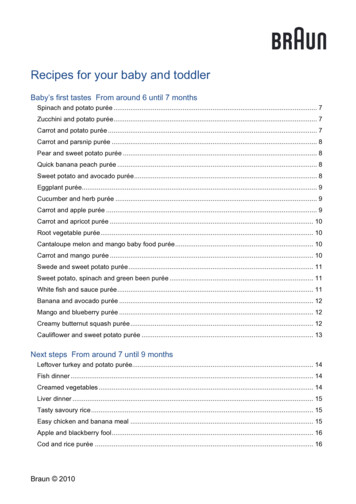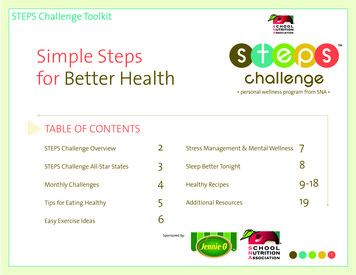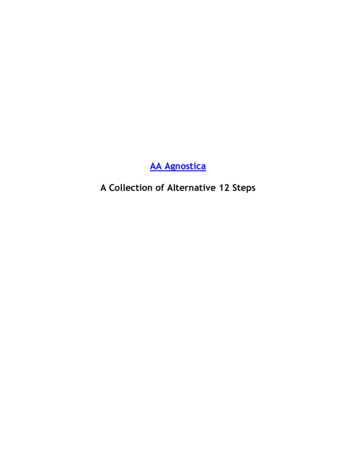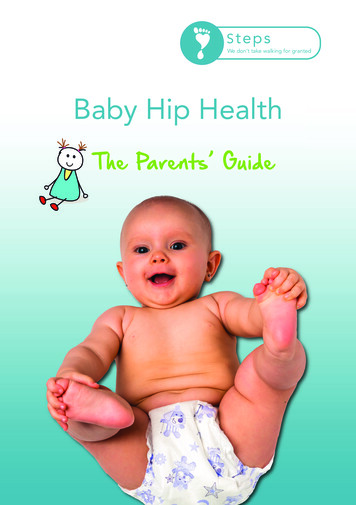
Transcription
S t ep sWe don’t take walking for grantedBaby Hip HealthThe Parents’ Guide
IntroductionIntroductionAt Steps, we understand how a lower limb condition can affectindividuals, families, and communities. Our commitment is to helpingpeople understand these conditions, offering reassurance and activelyworking for a better future, through our work with national healthservices and research projects. This booklet is for all parents. Itexplains why a baby’s hips are checked at birth, what the tests are andwhat happens if a problem is found. It also tells you how to keep yourchild’s hips healthy. It cannot tell you everything you need to knowabout what the future may hold, but we hope it will reassure you. It isalso intended to show that practical help, specialist medicalinformation, emotional support, and links to other sources ofinformation are all available, if needed. This will help youto be more prepared for the road ahead and haveinformation to hand so that you can ask informedquestions about your child’s care, treatment, andprognosis.Help When You Need ItSometimes being able to contactsomeone who knows what you aregoing through can provide muchneeded encouragement. Our FamilyContact Service can put you in touchwith others who have shared a similarexperience and can offer advice,support, and practical tips.You can also share your problems andsolutions to everyday challenges onour closed Facebook Group forparents.The group is a friendly and safe way ofdiscussing online your worries withother parents, sharing tips, and findingemotional support.Remember, theSTEPS Helpline teamare here to offerinformation and supportin total confidence andanswer any questions orconcerns you may have. This willhelp you to ask informed questionsat hospital appointments or may helpto reassure you along the way.No matter how big or small yourconcern, please telephone ourHelpline on 44 (0) 1925 750271 oremail info@steps-charity.org.uk forsupport and advice in total confidence.Social media details can be found on the back cover.2Steps Baby Hip Health - A guide to hip development – The Parents’ Guide
How does a baby’s hip grow?The hip joint is called a ball andsocket joint. The top of the thighbone is ball-shaped and fits into asocket on the side of the pelvis. Thisallows the leg to move both up anddown and side to side. For the hipjoint to grow normally theball-shaped head of the thigh boneneeds to be inside the cup-shapedsocket. Very young babies’ hips aremade of soft cartilage which changesinto bone over the first few years.For the joint to grow properly theball and socket have to be held firmlyin the right place. It is held in placeby ligaments, muscles, and a jointcapsule.Why are babies’ hips checked at birth?It is estimated that approximately 1 in 10 newborn infants has hip instability.That means the hips can be wiggled in the socket because of loose ligaments.Most of these loose ligaments will tighten up naturally after birth.Hip instability in babies is most frequently discovered at the time of thenewborn physical examination by physicians, according to nationalscreening pathways. The aim of the screening pathways is to identify all casesof hip instability so that observation and/or early appropriate treatment leadsto normal hip development.The challenge is to differentiate between a hip with instability that willspontaneously correct itself, from a hip with instability that may lead tosymptoms and a severe diagnosis such as developmental dysplasia of the hip(DDH). We will cover what DDH is later in the publication.Can the test pick up all hip problems?The hip checks are not 100% accurate. The physical examination only detectship instability at the time of the examination. Furthermore, physicalexamination of the hips requires skill and experience to perform. If the clinicalexamination is performed by untrained or inexperienced examiners, hipinstability may not be detected, or conversely normal hips may be thought tohave instability.The Parents’ Guide – Baby Hip Health - A guide to hip development Steps3
It is also important to understand that hip dysplasia is a developmentalcondition, therefore can develop at a later stage.It is therefore important to be aware of the key signs of hip dysplasia in the firstfew years of life of your baby.Potential symptoms may include: unequal leg lengths hip clunks or pops when changing a nappy one leg does not seem to move outwards asfully as the other or both legs seem restricted asymmetric buttock creases (though this is also seen in many normalbabies) in older children a limp if one leg is affected or waddling walk ifboth hips are impacted.DDH diagnoses can only be confirmed by either ultrasound or x-ray imaging.When are the baby’s hips checked?Most national screening pathways recommend checking baby’s hips at birth andat 6-8 weeks.The hips are tested as part of the national newborn physical examination whichis usually carried out in hospital before you go home. Newborn checks typicallycover eyes, testes, heart and hips.The healthcare professional undertaking the examination should explain what itinvolves. The examination can be performed by a doctor, midwife, health visitoror a medical professional who has been trained to do the examination.Do these checks cause my babyany discomfort?The manipulation is very gentle and should not causediscomfort, but most babies will object to beingexamined however gently. It can help to calm yourbaby by giving a breast or bottle feed before theexamination.4Steps Baby Hip Health - A guide to hip development – The Parents’ Guide
How are the hips checked at birth?During the examination, thehealthcare professional will note howyour baby holds his or her legs atrest. They will check to see if the legsare the same length, lie in a similarposition and whether the naturalthigh creases at the groin aresymmetrical.The baby’s hips are gentlymanipulated to see if they are safelyin joint by tests known as the Ortolaniand Barlow tests.The Ortolani Manoeuvre is used toscreen for a dislocated hip (adislocated hip will be felt clunkinginto place).In the Ortolani Manoeuvre, the babyis laid on his or her back and the hipsare moved gently outwards. Adistinctive ‘clunk’ (which is felt butnot heard) suggests a possibleabnormality and the joint may beclassed as unstable. It may becaused by the head of the thigh bonemoving in and out of the socket.‘Clicky’ sounds are not usuallyimportant: a ‘clicky hip’ can beentirely normal.Barlow ManoeuvreOrtolani ManoeuvreDuring the Barlow Manoeuvre, gentledownward pressure is applied to theleg to feel for the stability of the hipjoint. The Barlow Manoeuvre is usedto screen for a dislocatable hip (adislocatable hip will be displayed outof the joint by this manoeuvre).When the test shows a potentialproblem, it is called a positive test,while a test that reveals no problemis called a negative test. The healthprofessional will ask questions to findout if there are special risk factorsthat are associated with DDH. It iswise to discuss any family history ofchildhood hip problems now, if anopportunity has not arisen before.What are the risk factors?Hip dysplasia can happen to any baby but some factors, called ‘risk factors’,make the condition more likely.Unfortunately, to date, there is no international consensus in deciding whatconstitutes a significant risk factor. National health systems will apply theirown risk factors to determine if there is a need for an ultrasound.The Parents’ Guide – Baby Hip Health - A guide to hip development Steps5
The most common risks factors are: Breech presentation (bottom or feet first)Hip instability and/or physical signs suggesting a possible dislocatedhip during a clinical examinationPositive family history such as mother, father, brother or sister, havehad a hip problem treated as a child. DDH is more common in first pregnancies and in baby girls. Babies with mildfoot abnormalities or tightness in the neck are also more likely to be diagnosedwith DDH.My baby’s hip test is negative, but I have beentold she/he still needs an ultrasound?If your baby’s newborn physical examination is negative, but you have respondedpositively to one of the risk factors (i.e your baby was born breach or there is afamily history of hip instability), you will be automatically recommended anultrasound.National pathways recommend an ultrasound study at six weeks of age for babieswith DDH risk factors.My baby’s hip test is positive, what happens next?If during the newborn physical examination the healthcare professional identifiessome form of hip instability, your baby will be referred for an ultrasound within 6weeks.Sometimes a baby’s hip stabilises on its own before the scanis due, but it is important the hips are checked to ensure thatthe hips are stable.6Steps Baby Hip Health - A guide to hip development – The Parents’ Guide
What is an ultrasound examination?This is a harmless procedure very similar to ultrasound usedin pregnancy.Steps, in collaboration with the British Society of Children’sOrthopaedic Surgery (BSCOS) have produced a video toexplain the ultrasound.An ultrasound helps the doctors to obtain an accurate image of the hips tosee if they are well-formed and safely in the right place. It can identifyabnormalities of the shape of the ball and socket and see if the ball is unstable- whether it displaces out of the socket. These problems are not always feltwhen the hips are tested by hand. Sometimes, the ultrasound test may benormal when the physical examination suggested there might be a problem.Adminstering UltrasoundDuring the ultrasound examination, the hip is also examined for stability in thesame manner as the Barlow test, but the ultrasound is used to see if the hip isunstable instead of relying solely on a practical examination by the doctor.The Parents’ Guide – Baby Hip Health - A guide to hip development Steps7
What happens after the scan?At the end of the scan, the healthcare professional will discuss the results withyou. If the ultrasound scan is normal, no further tests are required. It is,however, good practice to ensure that a baby’s hips are developing healthilyby following a few tips as per the information on page 10.If the first ultrasound scan shows that your baby’s hip is immature or has aborderline result, a repeat scan will be arranged for 4 weeks following theinitial scan. Over this time, the hip may start to function normally and nothingelse will be needed.If an abnormality is seen on the second scan, you will be referred to aChildren’s Orthopaedic doctor who will be able to start treatment if necessary.What happens if they diagnose hip dysplasia inmy baby? Why does hip dysplasia happen?The exact cause or causes of hip dysplasia are not known and it is important tounderstand that it is not anyone’s fault. Even though as parents you may beconcerned at discovering your baby has hip dysplasia, he or she will not be in pain.Hip dysplasia does not affect your baby’s development such as crawling or walking.Although many people may think that Developmental Dysplasia of the Hip (DDH),is a rare condition, it is surprising to know that it is one of the most common hipconditions in children affecting 1-3% of all newborns.It is widely recognised by health professionals and researchers that hip dysplasiadevelops around the time of birth. This is because the hip socket is shallower atbirth which is a natural occurrence as the foetus grows in the womb and there islimited space for the baby to move. The shallow sockets may allow more flexibilityfor the baby to pass through the birth canal.It is also important to know that expecting mothers make hormones that helpligaments relax during the birth. These relaxing hormones can stay in a baby’sbloodstream for a few weeks making it normal for babies’ hips to be ‘stretchier’and looser shortly after birth. As girls usually have more loose ligaments thanboys, they are more likely to have hip dysplasia. Statistically they are 4-5 timesmore likely to have a hip dysplasia diagnosis than boys.8Steps Baby Hip Health - A guide to hip development – The Parents’ Guide
Loose ligaments mean that the hip is easier to be wiggled in the socket and,although in most of the cases ligaments tighten up naturally after birth,approximately 10% do not. If the ligaments around the hip joint are loose, thehip will subluxate. In medicine, a subluxation means that there is an incompleteor partial dislocation of a joint or organ. In hip dysplasia, this is when the ball isno longer centred in the socket.What is Developmental Dysplasia of the Hip?DDH encompasses a range of hip joint abnormalities, from mild instability tocomplete hip dislocations at birth. The hip joint is called a ball and socket joint.The top of the thigh bone is ball-shaped and fits into a socket on the side of thepelvis. This allows the leg to move both up and down and side to side. For thehip joint to grow normally the ball-shaped head of the thigh bone needs to beinside the cup-shaped socket. Very young babies’ hips are made of soft cartilagewhich changes into bone over the first few years. For the joint to grow properlythe ball and socket have to be held firmly in the right place. It is held in place byligaments, muscles and a joint capsule.DDH means the ball and socket do not fitcomfortably together: there are varyingdegrees of severity. If the ball (femoral head)is not held safely in place, the socket(acetabulum) may be more shallow than usual;this is called acetabular dysplasia.If the ball loses contact with the socket andstays outside the joint, it is called a dislocatedhip. These are all forms of DDH. One or bothhips may be affected.The Parents’ Guide – Baby Hip Health - A guide to hip development Steps9
What is the treatment for DDH?This varies with the severity of theproblem and the age of the child.Most babies are treated in some formof a splint, such as a Pavlik Harness,which keeps the hips flexed andabducted, so the legs are held splayedapart in the best position to encouragenormal growth. The splints can be madefrom webbing, plastic, or plaster of Paris.A few children’s hips do not respond toearly treatment, and some are notdetected until they are older. Theapproach to treatment for this group isdifferent and a number of treatmentoptions are available. These may includeadmission to hospital for special x-raysand a short period of traction, a smalloperation in the groin area under ageneral anaesthetic or a more extensiveoperation to put the ball and socket inplace. After these more complexprocedures it is normal to put the child ina plaster of Paris/fibre glass cast knownas a hip spica - a full body cast enclosingone or both legs. Children who need tohave their hips put back into place afterinfancy need to be monitored until theyare fully grown.Hip Health GuideHow do I look after my baby’s hip?It is normal for a babies’ hips to be ‘stretchier’ and looser shortly after birth. Babies’hips are always flexed so their thighs lie against their stomachs. They should beallowed to kick them straight on their own and not be stretched out. It is importantto leave the hips free to move and not tightly strapped down with the legs straightout and pressed together. Let your baby hold his or her hips bent up as they werein the womb and allow room for the legs to move freely.During the first six months of life, when the baby’s hips are growing rapidly, it isimportant to avoid activities or baby products that may affect hip positioning or hipmotor development.Should I swaddle my baby?Swaddling infants with the hips and knees in an extended position increases the risk ofhip dysplasia and dislocation. It is therefore important to use hip-healthy swaddlingtechniques to reduce this risk.10Steps Baby Hip Health - A guide to hip development – The Parents’ Guide
In order for swaddling to allow healthy hip development, the baby’s legs should be able tobend up and out at the hips. This position allows for natural development of the hip joints.The baby’s legs should not be tightly wrapped and pressed together.Many parents prefer a ‘sleeping bag’ specifically designed for swaddling, instead ofusing a simple cloth or blanket. When purchasing a commercial product, you will needto ensure that it allows plenty of room for healthy hip positioning. It is vital that theproduct allows the hips to spread apart and bend up. Sudden straightening of the legsto a standing position can loosen the joints and damage the soft cartilage of the socket.Can I carry my baby in a sling/carrier?Any equipment that restrains a baby’s legs in an unhealthy position should be considereda potential risk for abnormal hip development. When choosing a product, it is importantto assess the size of the baby, the length of time the baby will be placed in it and how thehips are impacted. The longer a baby is placed in a carrier that constraints the hips, thehigher the chances are that the hips are impacted.As such, if a sling is the preferred method to carry a baby around, it is important to choseone that promotes a healthy hip position during transport as per the picture below.A properly fitting, wide-based carrier that promotesthe M-shape, also known as the ‘spread squat’ orthe ‘jockey position’, are common options.The M-shape is where the baby has their thighsspread around the mother or father’s torso. Thebaby also has the hips bent so the knees areslightly higher than their buttocks, or at buttocklevel with the thighs supported.A good carrier should ensure that the thighs aresecurely supported all the way to the knees, whichare held above the bottom. The hip joints are in theoptimal position, and there is no weight at alldragging down on the joint.In this picture we can see a mother carrying a baby with thethighs spread around the torso and the hips bent so the kneesare slightly higher than the buttocks with the thighs supported.Parents are advised to research the general safety and risks ofany device they wish to use. When in doubt, we recommendinvolving your primary health-care provider in any furtherdecision-making that may be medically relevant.For practical advice and Q&A with health professionals onDDH and the Pavlik Harness please visit our YouTube channel.The Parents’ Guide – Baby Hip Health - A guide to hip development Steps11
take walking for granted.We don’tBabies & ne: 44 (0)1925 750271Email: info@steps-charity.org.ukSteps Charity Worldwide@STEPS CharitystepscharityworldwidestepscharitySteps registered charity in England and Wales (1094343),Scotland (SC049759) and also operating in Northern Ireland.Company number 4379997Externally reviewed and updated January 2022Acknowledgements:Steps wishes to thank all the health professionals and families whoprovided feedback and photos for the production of this booklet.Information in Steps Charity Worldwide publications is sourced from a range of reputable providers around theworld, including healthcare professionals, universities and healthcare societies. Steps Charity Worldwide does notprovide medical advice, diagnosis or treatment and the information in this factsheet is not intended to be asubstitute for professional medical advice. This factsheet is provided for informational purposes only. Always seekthe advice of a qualified healthcare professional as to your specific circumstances. We try to ensure that theinformation in this factsheet is correct at the time it was written but Steps Charity Worldwidemakes no representation and gives no warranty in respect of the accuracy or fitness for purpose of the informationin this factsheet, and accepts no liability for any personal injury or other loss or damage resulting from you relyingon this information.S te psWe don’t take walking for granted@ STEPS y/ - Steps Support dultsupport/ - Adult Support GroupHelpline number 44 (0) 1925 750 271email : info@steps-charity.org.ukThe Leading Charity for Lower Limb ConditionsRegistered charity in England and Wales (1094343), Scotland(SC049759) and also operating in Northern Ireland. A companylimited by guarantee, registered in England and Walescompany number 04379997.Registered office: The White House, Wilderspool Business Park,Greenalls Avenue, Warrington, WA4 6HL.
The Parents’ Guide – Baby Hip Health - A guide to hip development Steps 7 An ultrasound will be carried out within two weeks if the examination is abnormal. A more senior or experienced clinician may also exami

